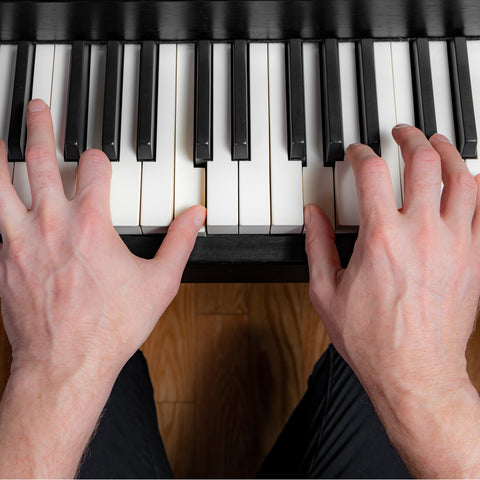Six Basic Chords for Kids

There are six basic chords that kids must learn in order to play the beginning piano literature. They are C, F, G, D, E, and A. Chords are groups of three piano keys played, in most beginning methods, with the left hand.
Just like the books below, they are stacked in a certain order: green, blue, red. They are the foundation of music, the DNA of sound. Having command of the chords gives any musician control over the piano, and heightens their ability to make music.

Introduce Basic Chords Early
While they are not the first thing I teach to kids, they are introduced very early. I always introduce them before reading music. The reason for this is that it is important for kids to have a way of ordering information at the piano other than reading music. Using chords to see patterns at the keyboard is one of the most valuable tools a pianist has.
The advantage of seeing the piano as a matrix of chords is that you can organize and compress information. Chords form readily identifiable groups that are easy to identify visually. Chords become a form of musical shorthand.
Examples of Chords
Learn these root position chords. If you played the three keys at the same time on a real keyboard, that is the sound of the chord:
Start With The C Chord
First of all, teach a child the C chord. Allow them to play a two-note chord, that is, the keys C and E. The reason for this is physical. You will confuse the child with the additional fingering gymnastics necessary to include that third note. Fingering is not really the issue. Even allow them to use two index fingers at first, if necessary, but they must “shake hands” with chords easily and without stress.
If you take this slow approach, using the fingers they offer at first, then later the child will be both physically and mentally ready to easily add the third member of the triad. Ask them to use the left hand, and if they offer the right hand, accept it for a while, giving them time to get used to the idea.
For some kids this may take weeks to penetrate, but be patient. At some point they will see how easy the task of forming chords really is.
Piano Is Easy
Don’t Confuse Chords With Fingering
Don’t let chords become confused with fingering. That’s why I separate the two concepts and get them to see the chords first visually and conceptually. Later, they can figure out the best way to attack the fingering.
This non-fingering at first approach does a lot to calm them and allow success at finding the six basic chords. After a while, ask them to use chords mostly in the left hand, so a physical habit is set up.
Ask them to use two of the strongest fingers of the left hand, the 2nd and 3rd. Explain that it’s like a sports team, where we use the strongest players first. After learning many songs by number, in which they play chords in the left hand and melody by number in the right hand, they are ready for chord games.
Chords With Black Keys
Wait until they master these white chords before you introduce the chords with black keys, D E and A. Older kids can easily play this game with three note chords. I start with C F and G chords. I wait a while before I introduce the three chords with a black key, D E and A.
Give Them A Clue About The Black Keys At First
For the first month or so, or as long as necessary, I always say, “Play a D chord with a black in the middle, please!” You have to give them the security of not guessing whether a chord has a black key until they get the idea. Stop saying “with a black key” after you’re absolutely certain they know there are three all white chords, C F and G, and three chords with a black in the middle, D E and A.
Test them on the six chords, often, comically, theatrically, test them in any way you can get their attention. You must get them to understand these six building blocks before proceeding further.
BOOKS FOR YOUNGER KIDS
BOOKS FOR OLDER KIDS
REFERENCES
Chords
Kids Learn Chords
Basic Piano Chords For Kids
Root Position Chords
First Inversion Chords
Second Inversion Chords
Two Note Chords For Kids
Two Note Chords for Younger Kids
What Is A Root Position Chord?
Chords for Kids





